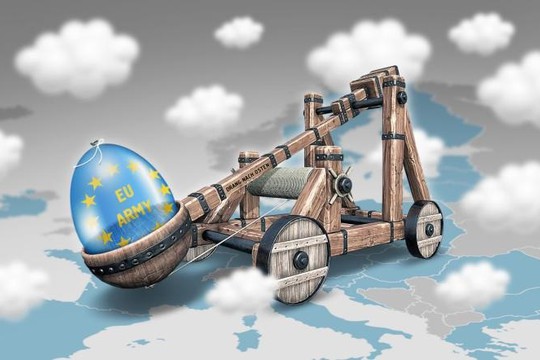Pic.: pogled.info
“Europe wants to stand on its own militarily, but what’s holding it back and how long will it take?” – a group of analysts from Center for European Policy Analysis (CEPA) puts a question.
Recent weeks have demonstrated there’s still some sprightliness and even dynamism in the old continent. A whirlwind of initiatives has produced a $1 trillion-plus geyser of money to re-arm, most recently in Germany’s impending decision to uncap defense spending.
That’s because the European Union’s 27 member states, the UK, Norway and others have recognized that the Trump administration is relaxed about their safety (see Vice President JD Vance’s February speech playing down the threat from Russia and China), and may even turn openly hostile if, for example, Europe joined Ukraine in rejecting a Trump-brokered peace deal.
“We are living in the most momentous and dangerous of times,” European Commission President Ursula von der Leyen said on March 4 as she presented the ReArm Europe plan, aimed at bolstering the continent’s defense. Just 15 days later, the Commission produced another key defense strategy paper, Readiness 2030, on rearmament and the need to buy within Europe.
Europe’s ReArm Europe/Readiness 2030 program should help. Providing $160bn in loans and another $700bn in other funding, it will mark a sea change of increased funding and better coordination.
The rush to rearm presents two key questions. The first is whether the US will make any further military or intelligence contribution to continental defense, either in peacetime or wartime. This will determine the time Europe has available; and the answer is currently unclear. The second is how long it will take to replace the capabilities Europe currently lacks.
“The difficult reality is that Europe is today unprepared for US abandonment, having for decades neglected their defenses and taken the US security guarantees for granted,” said Daniel Fiott, Head of the Defense and Statecraft Program at CSDS in Brussels.
Despite significant increases in defense spending in recent years, Europe still lacks critical military capabilities, ranging from ground forces to air and missile defense. But how long will it take before Europe can credibly deter aggression on its own?
There is no quick fix. Even with political will and increased spending, experts agree that achieving true military self-sufficiency will take years, if not decades.
However, addressing Europe’s most critical capabilities gaps, such as air and missile defense, long-range strikes, and intelligence, surveillance, and reconnaissance (ISR), will take longer — to take one example, a European airborne early warning aircraft to match the Boeing E7 would be a huge, medium term endeavor and is currently not even under consideration.
“A minimum of five years would be needed for the Europeans to fill in the capability gaps they have left growing over decades,” said Fiott. Others, like Rafael Loss, policy fellow at the European Council on Foreign Relations (ECFR), estimated that building up big combat-ready land formations, logistics, air defense, long-range strikes, and ammunition could take five to 10 years.
Achieving full military autonomy from the United States would take much longer. “Strategic air strike capabilities [cruise-missile carrying, long-range heavy bombers] would be the hardest by far,” said Alexandr Burilkov, Assistant Director for Research at the GLOBSEC GeoTech Center, adding that logistics and long-range air defense would also be difficult to scale up quickly.
Over the last year, European defense spending jumped by 11.7% in real terms, reaching more than $450bn, approximately 1.9% of EU GDP.
French President Emmanuel Macron has called for defense spending of 3%-3.5% of GDP in response to the long-term security challenges posed by Russia. That would mean at least an extra $225bn in annual outlays.
But experts warn that sudden spending surges can backfire. “If there’s a special fund, we will buy anything, but in any case, the manufacturers will not be able to deliver,” said Maulny, referring to the risk of short-term, poorly planned investments like Germany’s Zeitenwende fund.
Even with sustained investment, however, Europe’s defense industry is not structured for rapid expansion. Simply injecting more money will not fix structural inefficiencies that have built up over decades. Fragmented procurement, fragile supply chains, and slow production cycles continue to undermine efforts to close capability gaps.
Europe’s defense market remains badly fragmented, with individual nations continuing to prioritize domestic industries over joint European initiatives. As a result, more than 154 different types of weapons are being used in the European Union, compared to 24 in the United States, while at the same time, critical capabilities such as air defense aren’t being acquired. This duplication of efforts inflates costs, complicates logistics, and limits Europe’s ability to mass-produce the weapons it urgently needs.
The US supplied 64% of European NATO countries’ arms imports between 2020 and 2024, up from 52% in the previous five years. But even if European trust survives the policies of the Trump administration, the US cannot supply the continent’s rearmament needs. There is a huge defense order backlog. The money being spent on F-35s will only bring aircraft to Europe after delays of several years (even if the plane is still regarded as reliable by its buyers, which is now questionable).
“US defense firms are simply not capable of meeting Europe’s extensive and comprehensive military requirements on the necessary, urgent timelines,” according to Jennifer Kavanagh, senior analyst at Defense Priorities.
Europe’s defense manufacturing base has been hollowed out since the Cold War, leaving it ill-equipped for rapid wartime production. Without long-term financial certainty, defense manufacturers won’t expand factories or invest in workforce growth, delaying production for years.
read more in our Telegram-channel https://t.me/The_International_Affairs

 11:29 30.03.2025 •
11:29 30.03.2025 •























